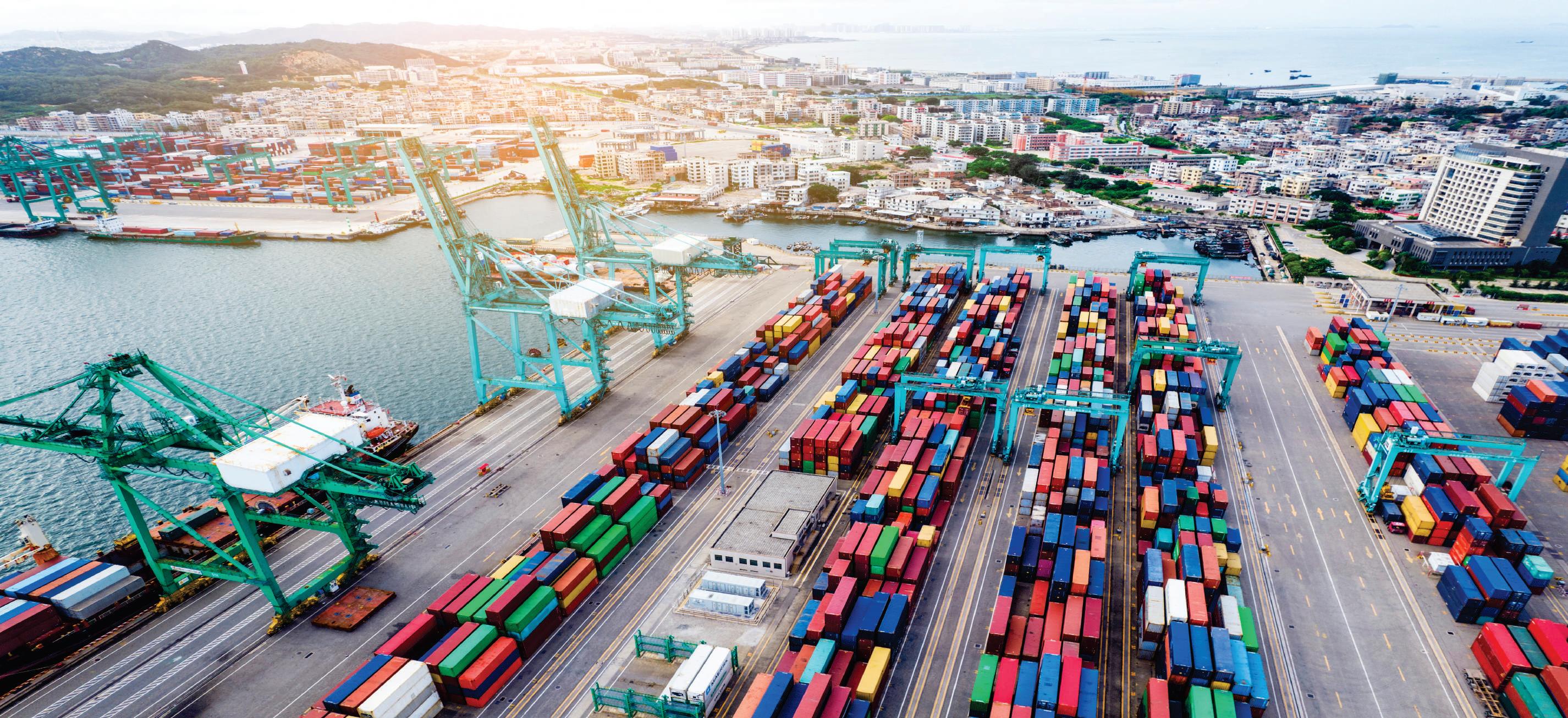
7 minute read
SATHIAMOORTHY GOPALSAMY
[ 130 ] | COLUMN
Advertisement
MANAGING DIRECTOR TECNIMONT PRIVATE LIMITED (MAIRE TECNIMONT GROUP)
Over the past decade there has been a greater emphasis on building a more sustainable economy from both developed as well developing nations by steadily moving away from the usage of fossil fuels. Transitioning from a linear to a circular economy is perhaps the only viable solution that can ensure achieving the UN sustainability goals. It underscores the need to shift towards the use of renewable resources and aims at eliminating waste through the superior design of materials, products, systems, and business models. It's even more important for a country like India to adopt a circular economy path on a more proactive basis, as it is the third highest emitter of greenhouse gases and accounts for 9.2% of total world emissions.
There has been a greater amount of emphasis by both the Government of India and domestic companies to help the country in its mission towards a clean energy transition. To reduce the carbon footprint, an increasing number of companies across the globe are now exploring the green hydrogen option, which has been labelled as one of the cleanest forms of energy in the world.
We at Maire Tecnimont S.p.A., an Italian based industrial group which leads the global natural resource processing industry (downstream oil & gas plant engineering, with technological and executive expertise), through our Group subsidiary NextChem operating in the field of green chemistry and technologies in support of the energy transition, have found technologies’ solutions able to make the energy transition possible. NextChem is well-placed to play both the roles of partner and coordinator in several international research projects.
NextChem’s green acceleration roadmap is focused on three areas of activity: Greening the Brown – technologies for the reduction of pollutant and GHG emissions released from existing plants; Circular Economy – mechanical recycling and waste-to-chemical technologies for the chemical conversion of plastic waste and other discarded materials.
Waste that can be recovered via chemical recycling includes, for example, mixed plastic packaging from urban waste collection, refuse derived fuels and the so called “dry-fraction” of waste derived from the mechanical-biological treatment of mixed waste. Through a chemical conversion process where hydrogen and carbon contained in the waste are recovered, a synthesis gas is obtained that can be used to produce compounds like ammonia, methanol, ethanol, and hydrogen.
Chemical recycling which is a thermal process but differs from incineration because the chemical conversion happens via oxygen, and not by reaching the combustion point. The process is known as “partial oxidation” and uses pure oxygen as an oxidiser. The conversion phase is followed by a subsequent purification phase which stops pollutants from being emitted into the atmosphere. The gas obtained can be considered “circular” as it derives from post-consumer materials. The residues from the process are inert and can be reused in industrial applications such as brick making. Finally, Green-Green is the third area of activity consisting of technologies which use biomass or biological raw materials to produce intermediates, biofuels and bio-plastics.
In this context, NextChem has developed the Green Circular District Model. The Green Circular District brings benefits to the environment, the economy, and society through decarbonization, recycling and recovery, production, employment, and local economic development.
This model integrates proprietary and licensed technology already proven, available and ready to be industrially implemented, and it allows to realize industrial projects which are environmentally, socially, and economically sustainable.
The Green Circular District model is mainly aimed at green recovery of industrial brownfield sites, above all in petrochemical and steel sectors. The aim of the model is to produce high quality recycled polymers,
COLUMN | [ 131 ]
circular chemicals, and low carbon fuels, replacing fossil sources in industrial processes (as natural gas or hydrogen from methane) with feedstocks (renewable or circular) with a significantly lower carbon footprint, which allow to reduce CO2 emissions of industrial sites and to enhance recycling while improving circular economy. Finally, the production of chemicals which are the building blocks for the industry using already existing sites, as well as waste as feedstock, allows to reduce virgin raw materials supply.
The Green Circular District can become the driving force for the shift from a linear economy (manufacture-consume-dispose) to a circular one (manufacture-consume-recycle-remanufacture), using materials and substances derived from recycling which can be used again in the production of goods and the energy and chemical industries improving overall environmental impacts. The model is based on the integration of green chemistry technologies such as MyReplast Upcycling, Chemical recycling and the production of green hydrogen via electrolysis technology.
MyReplast Upcycling is a technology that allows to mechanically recycle several polymers which compose post-consumer plastics, and to obtain high-added-value recycled materials with the same properties as fossil-based plastics. The term Upcycling was coined by a Germa n mechanical engineer named Reiner Pilz in 1993, who explained the concept as follows, “Recycling, I call it down cycling. They smash bricks, they smash everything. What we need is upcycling, where old products are given more value, not less”.
The Waste-to-Chemical technology developed by NextChem, through its subsidiary MyRechemical, allows plants to produce added-value circular chemical products from waste. The starting point is the high percentages of carbon, and to a lesser extent hydrogen, contained in waste. Technically speaking, the technology combines non-recyclable plastic waste (sorting scraps from plastic packaging waste) with RDF (Refuse Derived Fuel) or dry fraction chemical conversion to obtain a circular gas known as syngas. From syngas it is possible to obtain circular methanol, ethanol, and hydrogen. The latter can subsequently be used to power industrial plants or public transport networks at competitive prices and with a lower carbon footprint.
Hydrogen is a fundamental energy carrier: it can be used as a fuel and as a feedstock in many industrial processes, it is storable and transportable over long distances. Hydrogen will play a key role in the decarbonization process. It can be used in transport, as a raw material in several industrial sectors such as steel or chemical, or as a building block to produce different products, such as fertilizers.
NextChem's portfolio includes different technologies for the production of hydrogen: Electric Blue Hydrogen based on traditional know-how but which involves the use of electricity to feed the endothermic reactions of methane steam reforming. Electric Blue Hydrogen can reduce the amount of CO2 emitted by 45% compared to the traditional process. The innovation is, beyond the CO2 capture, the electrification of the process, to which is added the possibility to use energy from renewable sources to provide the heat for the reaction.
Green hydrogen, produced via water electrolysis technology using renewable energy sources is the only zero carbon option. Green hydrogen competes with both fossil fuels and other “shades” of hydrogen, because it is the most sustainable version but its production still poses problems in terms of costs and continuity of the energy supply. For a widespread application of hydrogen, it is important to produce a sufficient volume to meet the demands of industry, using sectoral synergies and providing flexibility to the energy system.
Circular Hydrogen can help to solve the problem of non-recyclable waste, which is currently incinerated or disposed of in landfill. Beyond the environmental benefits, the production costs are competitive compared to traditional hydrogen. Plants producing circular hydrogen could be located in traditional energy-intensive industrial sites, such as refineries, where they can contribute to their decarbonization, or close to waste sorting plants where they would optimize logistical processes while reducing carbon footprint also in the transportation phase.
With NextChem being created under the fold of Maire Tecnimont, our vision is to contribute towards the global drive to support the green energy transition with most of the public and private companies working on Green Hydrogen, Green Chemistry, or Circular Economy initiatives and more.
We acknowledge that India has enormous potential in this field. We have robust daily waste generation due to high population, however, most of the municipal bodies are struggling to dispose of the same. NextChem’s integrated solution is equipped to handle and create value added products out of this municipal solid waste, turning the problem of its disposal into an opportunity for growth. n










